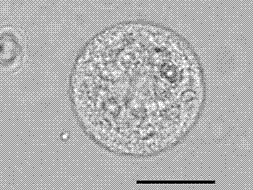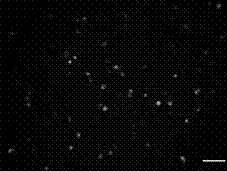Sugarcane callus protoplast separation and purification method
A technology of protoplast and callus, applied in the direction of plant cells, can solve the problems of insufficient quality and quantity, and achieve the effect of good uniformity, high quality and sufficient quantity
- Summary
- Abstract
- Description
- Claims
- Application Information
AI Technical Summary
Problems solved by technology
Method used
Image
Examples
Embodiment 1
[0024] Embodiment 1: a kind of separation and purification method of sugarcane callus protoplast comprises the following steps:
[0025] 1. Sugarcane callus culture: select sugarcane tips with normal growth and no pests and diseases, remove the peripheral old leaves until the highest visible hypertrophic leaves and excess leaves growing from the top, and retain 25 cm long heart leaf tissue; use volume ratio After scrubbing and disinfecting the surface with 75% alcohol solution, the sugarcane heart leaf tissue was cut into 1.5 cm thick slices in a sterile ultra-clean workbench, cultured on MS3 solid medium at 28 ℃ for 1.5 months in the dark, every Subculture once every 2 weeks;
[0026] 2. Suspension cell culture of sugarcane: select 5 grams of dense, golden yellow, and granular embryogenic callus, mash it, transfer it into 100 mL MS3 liquid medium, and culture it in the dark at 28°C for 2 weeks. The culture solution was filtered with gauze, and the filtrate was allowed to sta...
Embodiment 2
[0030] Example 2: Using protoplasts isolated and purified from heart leaf callus of sugarcane variety CP72-1210, the activities of silencing suppressors encoded by different plant viruses were studied.
[0031] 1. PEG genetic transformation
[0032] 1.1 Put the prepared sugarcane CP72-1210 callus protoplasts in ice bath for 30 min, remove the W5 solution, and suspend the protoplasts with 1-2 mL MMG solution to a concentration of 2×10 per ml 5 indivual.
[0033] 1.2 Take 5 μL of pUbi-EYFP-Nos and pUbi-P19-Nos plasmid DNA (1 μg / μl), 5 μL of pUbi-EYFP-Nos and pUbi-γb-Nos plasmid DNA (1 μg / μl), 5 μL pUbi-EYFP-Nos and pUbi-Nos plasmid DNA (1 μg / μl) into 2 mL centrifuge tubes.
[0034] 1.3 Add 100 μL sugarcane CP72-1210 protoplasts, mix, add 110 μL 40% polyethylene glycol solution (PEG-4000), mix well, and incubate at room temperature for 5-15 min.
[0035] 1.4 Add 440 uL W5 solution, mix well, stop genetic transformation, and centrifuge at 100 g for 2 min. The supernatant was d...
example 3
[0040] Example 3: Using the protoplasts isolated and purified from the heart leaf callus of sugarcane variety CP72-1210, the activities of different promoters were studied.
[0041] 1. Transient expression of transgene
[0042] 1.1 Put the prepared sugarcane CP72-1210 callus protoplasts in ice bath for 30 min, remove the W5 solution, and suspend the protoplasts with 1-2 mL MMG solution to a concentration of 2×10 per ml 5 indivual.
[0043] 1.2 Take 10 μL of plasmid DNA (pPr4-GUS-NOS, pUbi-GUS-NOS, p35S-GUS-NOS, 10 μg) into 2 mL centrifuge tubes, and set empty vector (pUbi-NOS) and water as blank control.
[0044] 1.3 Add 100 μL of protoplasts, after mixing, add 110 μL of 40% polyethylene glycol conversion solution, mix well, and incubate at room temperature for 5-15 min.
[0045] 1.4 Add 440 μL of W5 solution and mix gently to terminate the genetic transformation, and centrifuge at 100 g for 2 min. The supernatant was discarded, and the protoplasts were suspended in 1 mL WI...
PUM
 Login to View More
Login to View More Abstract
Description
Claims
Application Information
 Login to View More
Login to View More - R&D
- Intellectual Property
- Life Sciences
- Materials
- Tech Scout
- Unparalleled Data Quality
- Higher Quality Content
- 60% Fewer Hallucinations
Browse by: Latest US Patents, China's latest patents, Technical Efficacy Thesaurus, Application Domain, Technology Topic, Popular Technical Reports.
© 2025 PatSnap. All rights reserved.Legal|Privacy policy|Modern Slavery Act Transparency Statement|Sitemap|About US| Contact US: help@patsnap.com



